| Oracle® Argus Insight Administrator's Guide Release 7.0.3 E48111-01 |
|
|
PDF · Mobi · ePub |
| Oracle® Argus Insight Administrator's Guide Release 7.0.3 E48111-01 |
|
|
PDF · Mobi · ePub |
Argus Insight provides built-in standard reports that you can run on active case series to analyze your company's safety, workflow, and product data.
This chapter includes the following topics:
Although standard reports are predefined reports, you can define pre-filters before generating a standard report to have the report output display information only about specific types of cases. Pre-filters let you narrow down the case series further so that the system runs the report only on those cases that conform to the pre-filter criteria.
For example, suppose your case series consists of cases that were reported in all countries for a particular product. However, you only want information about cases reported in the United States. In this case, you can specify a pre-filter such that the report output includes only those cases that were reported in the United States.
Because a case series might become obsolete each time the data mart is refreshed by running an ETL, you may need to generate the case series again before generating a standard report.
Alternatively, you can directly associate a query (QBE, filter, or advanced condition) to a standard report to avoid manual generation of the case series. For more information, see these topics:
The STANDARD REPORTS page, shown in Figure 8-1, lists all the standard reports built in to Argus Insight.
To display the STANDARD REPORTS page, navigate to Reports, Standard Reports, and select an option.
The STANDARD REPORTS page displays the following information for each report:
Name of the report.
Brief description of the report.
Date when the report was last modified.
Author of the report. For standard reports, the author is Oracle Corporation.
In addition, the STANDARD REPORTS page provides several standard tools to help you find a specific report or group of reports. You can:
Scroll up and down to browse through the list.
Click a column heading to sort the list.
Enter keywords in one or more column fields and then click Search to find reports that satisfy your specified criteria
To generate a standard report:
Navigate to Reports and select Standard Reports.

Select the report category, such as General, to view a list of standard reports for that category.
The STANDARD REPORTS page opens and lists the standard reports for the category you selected.
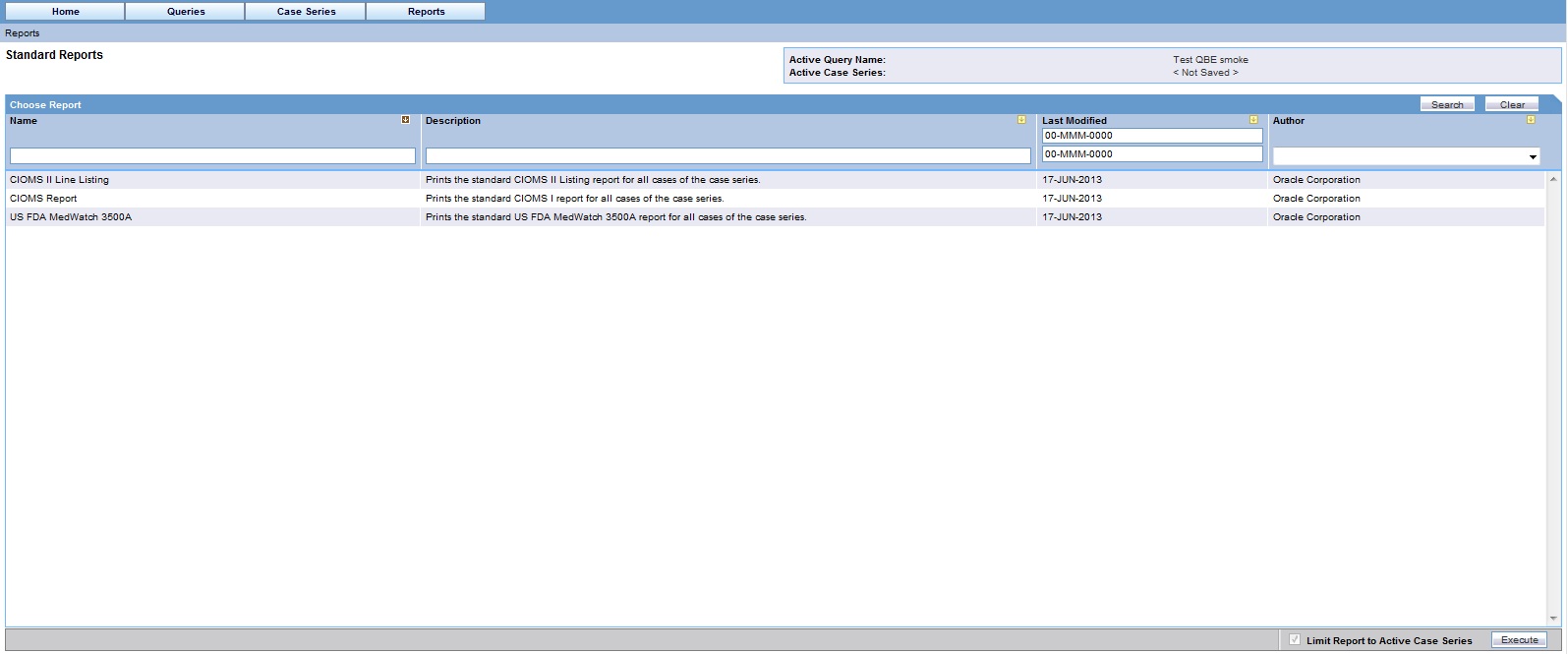
Select the report that you want to generate.
You can scroll through the list to find a report, click a column heading to sort the list, or search for report based on the criteria you specify in the column fields.
Note:
The Limit Report to Active Case Series check box is checked and disabled. This prevents the report from querying the entire data mart and slowing down the report output generation.To view the currently active case series, navigate to Case Series, Open Case Series, and select Active. To make a different case series active, navigate to Case Series, Open Case Series, and select Library. When the CASE SERIES LIBRARY page opens, select the case series you want to make active and click Make Active.
Click Execute. The system generates the report and displays the output in the selected format. You can print this report or save it to the system drive, if required.
Close the new browser window to return to the STANDARD REPORTS page.
Report packaging is the concept of grouping reports together. You can define multiple reports that are always or often executed at the same time into a group. A set of reports run on a weekly or periodic basis can be scheduled and run as a package.
In Argus Insight, you can associate a report group and the report scheduling to a power query (QBE, Filter Value Set, and Advanced Conditions) or to a case series.
Argus Insight lets you associate the report group, schedule a time to generate the reports, and automatically send the completed reports through email to one or more users that you specify.
Note:
To be able to schedule reports, you must have an enterprise login configured in the Business Intelligence tool you are using with Argus Insight.To associate reports with a query or case series:
You can select any query from any library (Query By Example library, Filter library, Advanced Conditions library, or Query library) and click Associate.
You can select any case series from the CASE SERIES LIBRARY page and click Associate.
You can use the Query library and the Associated Reports library to schedule an association.
Because you can associate multiple reports with a single query, clicking Execute does not generate the report after generating the case series.
When you select either a query or a case series and then click Associate, the system opens the Scheduled Reports Group dialog box. See Figure 8-2.
The Scheduled Reports Group dialog box displays information about all the report groups created by all the users in the same user group. In a CRO setup or hosting installation, the system displays the report groups specific to the enterprise.
Each group can contain one or more reports. A report group means that all the reports are scheduled for the same time for a power query or a case series.
To view a list of the reports in a group, position the cursor over the group name in the Scheduled Reports Group dialog box. For example:

The Scheduled Reports Group dialog box provides the several tools for viewing, sorting, and searching the report groups. You can:
Use the scroll bar and pagination icons to browse through the list of report groups.
Click a column heading to sort the report groups according to the selected column.
Use the Filter icon to enter search criteria into fields and click Search to find the report groups that match your search criteria. You can click Clear to remove all search criteria. You can click the Close icon to hide the search fields. The search fields are hidden when you open the dialog box.
Note:
If you search for a text comprising an underscore, it is treated as a wildcard and is replaced by a letter in the displayed results. For example, If you have queries with names - CURE, CORE, and CARE and you search for C_RE, all three queries are displayed in the result.
The Scheduled Reports Group dialog box has the following commands buttons:
Click New to create a new report group. You can select Association only or Scheduling from the context menu. Once you make your selection, the system opens the Reports Scheduling dialog box.

Click Modify to change the settings for an existing scheduled report group.
Click Delete to remove the selected report group. You can delete a report group only if the report group is not associated with a query or case series.
Click Execute to close the Scheduled Reports Group dialog box, and then execute the query/case series in the parent window. The Execute button is enabled only if the scheduled report group has a single report.
Click Save to save your changes after you associate (or disassociate) a report group by selecting (or clearing) a check box in the Associate column.
Click Close to close the Scheduled Reports Group dialog box.
To associate an existing report group to a selected query or case series:
Navigate to the QUERY LIBRARY page or the CASE SERIES LIBRARY page.
Select the query or case series for which you want to associate a report group.
Click Associate. The Scheduled Reports Group dialog box opens.
Select the check box in the Associate column for the report group that you want to schedule for your selected query or case series. You can associate one or more report groups for your selected query or case series.
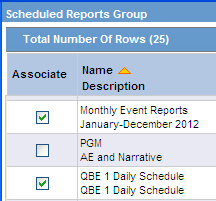
Click Save. The report groups are now scheduled for the selected query or case series.
To remove the scheduling of a report group for a selected query or case series, clear the check box in the Associate column and click Save.
To create and schedule a new report group for a query or a case series:
Navigate to the QUERY LIBRARY page or the CASE SERIES LIBRARY page.
Select the query or case series for which you want to create, schedule, and associate a report group.
Click Associate. The Scheduled Report Groups dialog box opens.
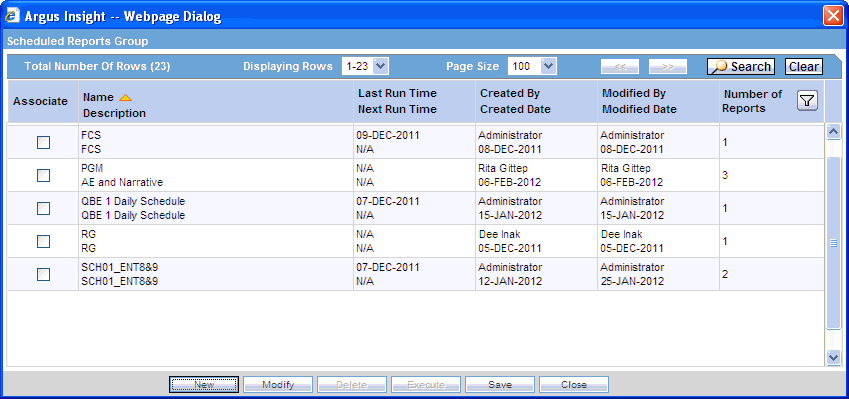
Click New. The system opens a menu with options for associating a report only or for scheduling and associating a report.

Click Scheduling to open the Reports Scheduling dialog box. See Figure 8-3.
See the following sections for information about completing the Reports Scheduling dialog box, including:
The Reports Scheduling dialog box is the main scheduling page in Argus Insight. See Figure 8-3. From this dialog box, you can select any number of reports for scheduling.
The Reports Scheduling dialog box has the following sections:
Group Information
Scheduling Information
E-Mail Information
Available Reports
Selected Reports
In the Group Information section, use the Name and Description fields to enter a title for the report and a brief summary of the report.
In the Scheduling Information section, click the Frequency field to specify how often you want the system to run the selected QBE and generate the selected reports. The options available are Once, Daily, Weekly, Monthly, Quarterly, and Yearly.
Based on the frequency option you select, the Scheduling Information section displays additional parameters that you must specify. For example, if you choose to run the report weekly, the system prompts you to enter the day, the time, the start date, and the end date.

Based on the frequency option you select, enter the additional scheduling information:
Once — Enter the date and time when the system will generate the report.
Daily — Enter the time when the system will generate the report. The system generates the report every day at the specified time. In addition, enter the start date and the end date for this schedule.
Weekly — Select the day of the week when the system will generate the report. In addition, enter the time, the start date, and the end date for this schedule.
Monthly — Select the day (1-31) of the month when the system will generate the report. In addition, enter the time, the start date, and the end date for this schedule.
Quarterly — For reports generated quarterly, the system automatically generates the report on the first day of the quarter. You enter the time of day when the system generates the report, as well as the starting and ending dates.
Yearly — Enter the date and time when the system will generate the yearly report. In addition, enter the start date and the end date for this schedule.
Note:
In the Time field, you must enter the time value in the HH:MM AM/PM format. Hours must be between 1 and 12.If you are scheduling a report group for a case series, you have the option to run the reports immediately. For case series, the Scheduling Information section includes a Run Now check box.

When you select the Run Now check box and save the scheduling information, Argus Insight saves the schedule to execute immediately.
Note that:
The Run Now option is available only when you schedule a report group for a case series.
When you select the Run Now option, all other settings in the Scheduling Information section are disabled. In addition, changes you make in the E-Mail Information section or the Selected Reports section when using the Run Now option do not affect the existing report group information.
The ASSOCIATED REPORTS LIBRARY page does not list the report groups scheduled using the Run Now option.
The Associated Reports Count tooltip on the CASE SERIES LIBRARY page does not include Run Now schedules in its count.
The Scheduled Reports Group dialog box displays a new row for each report group schedule that you create using the Run Now option. For example:
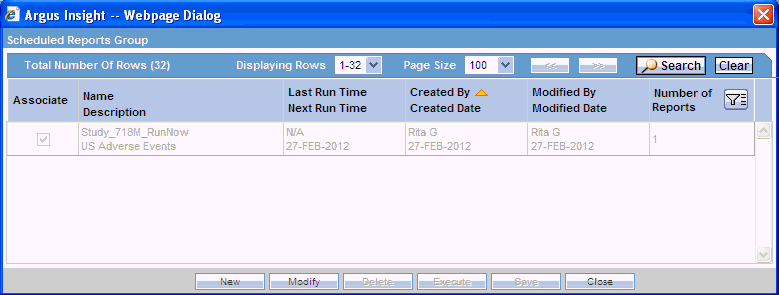
Note that the system:
Appends the _RunNow text to the report group name to indicate that it was scheduled using the Run Now option.
Displays the row in read-only mode (grayed out). You cannot select this row; you cannot perform any operation available in the dialog box on this row.
Displays the row only until all the related scheduling activities are completed.
Makes the row visible only to the user who created the Run Now schedule.
In the E-Mail Information section, enter the email address of each report recipient. If there are multiple recipients, use a semicolon (;) to separate each address.
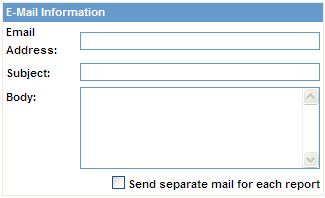
Enter the subject and body text for your email. For example, you may want to include general information about the reports generated, the scope of the report, the time frame of the report, and who to contact for additional information.
You can schedule multiple reports for a single QBE. Be sure to select the Send separate mail for each report check box if you want the system to send an email notification for each report generated.
The Available Reports section lists all the reports that you can include in the schedule and associate with the QBE.
To help you locate specific reports, you can:
Click a column heading to sort the list of reports by the selected column.
Click the Filter icon to display search fields below the column headings, enter one or more values, and then click Search to find the reports that match your criteria.
Scroll up and down to browse through the list.
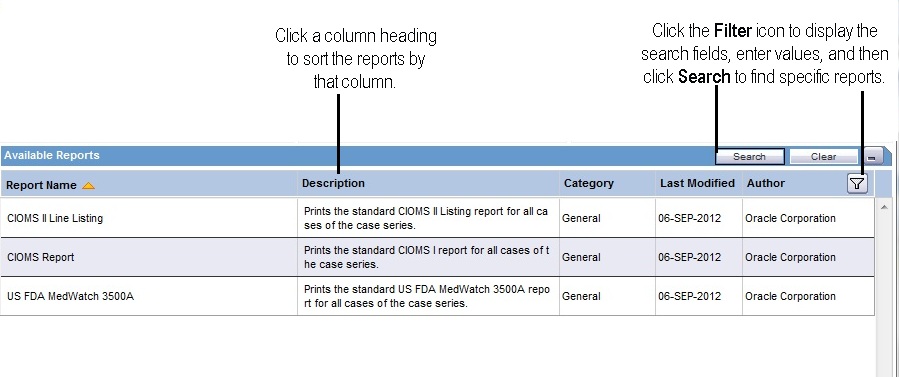
In the Available Reports section, select a report that you want to include in this scheduling and then click Add. The system displays the report in the Selected Reports section. Continue to select and add each report that you want to include in this scheduling.
If you want to remove a report from this scheduling, click the Delete icon. The system prompts for confirmation before deleting the report.
For each report that you select to include in this scheduling, the system displays the report name and category in the Selected Reports section.
In the Report Format column, select the output format for each report. You can select either PDF or Excel.
If you want to remove a report from this scheduling, click the Delete icon. The system prompts for confirmation before deleting the report.
Click OK in the Reports Scheduling dialog box to save your report scheduling.
The system associates the report group with the selected query or case series, saves the scheduling information, and returns to the Scheduled Reports Groups dialog box.
Note that the system automatically selects the Associate check box in the Scheduled Reports Groups dialog box to indicate that reports are associated with the query or case series. Position the cursor over the report name to list the associated reports.
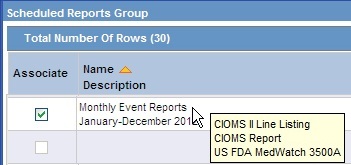
Close the Scheduled Reports Groups dialog box to return to the starting library page. Note that the Associated Report column now displays an icon to indicate that reports are associated with this query or case series. Position the cursor over the icon to display the number of reports associated.
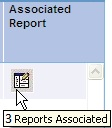
This section lists the Argus Insight standard reports. The reports are grouped by category; a title and brief description are listed for each report.
Table 8-1 describes the standard General reports.
Table 8-1 Standard General Reports
| Report Title | Description |
|---|---|
|
CIOMS II Line Listing |
Standard CIOMS II listing report for all cases of the case series. |
|
CIOMS Report |
Standard CIOMS I report for all cases of the case series. |
|
US FDA MedWatch 3500A |
Standard US FDA MedWatch 3500A report for all cases of the case series. |